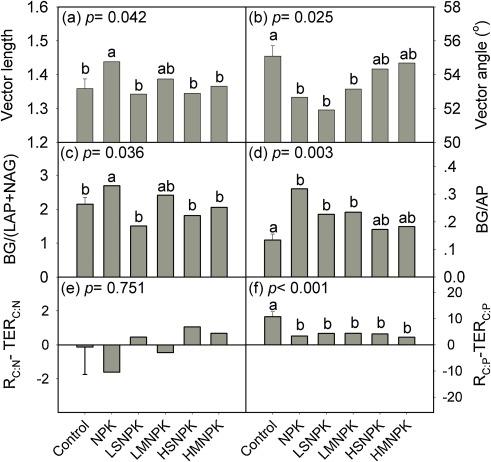- You are here: Home > Research > Research Progress
Microbes regulate many soil processes including carbon (C), nitrogen (N) and phosphorus (P) transformations, and thus play a key role in energy flow and nutrients release. However, these microbial-controlled processes are strongly dependent on microbial biomass or activity, which is mostly limited by energy and nutrient availability. This is called microbial resource limitation or substrate limitation. The status of microbial resource limitation, however, can be altered in agro-ecosystems due to application of inorganic fertilizers and organic fertilizers (e.g. straw or manure) alone or in combination, because fertilizer inputs may change the relative availability of soil C, N and P.
Studying how soil microbial resource limitation changes under different fertilization strategies is important for identifying effective fertilization strategies to improve soil C sequestration and crop productivity in agro-ecosystems. First of all, microbes are an important C source in soil. Moreover, investigation of soil microbial resource limitation is useful for identifying fertilization strategies in order to improve soil C pool or crop productivity. Although the effects of fertilization on crop growth or production have been commonly studied to identify suitable fertilization strategies, to our knowledge, few studies have directly assessed how microbial resource limitation status changes under different fertilization strategies in agro-ecosystems.
In a paper in Soil and Tillage Research, researchers in the Institute of Subtropical Agriculture, Chinese Academy of Sciences (ISA) investigated the effects of long-term (11 years) fertilization on microbial resource limitation in a karst cropland under maize–soybean rotation. Soil microbial resource limitation was assessed using enzymatic stoichiometry. Six fertilization strategies were included, i.e., i) no fertilization (control), ii) inorganic fertilizers only (NPK), iii) inorganic fertilizers plus a low amount of straw (LSNPK), iv) inorganic fertilizers plus a low amount of manure (LMNPK), v) inorganic fertilizers plus a high amount of straw (HSNPK), and vi) inorganic fertilizers plus a high amount of manure (HMNPK).
The team found that soil microbes were not limited by N, but co-limited by C and P across the six fertilization strategies. However, the degrees of microbial resource limitations were different between the control and fertilizer treatments. Application with inorganic fertilizers only aggravated microbial C limitation, but combined application of inorganic fertilizers and organic matters did not change the status of C limitation relative to the control. None of the fertilizer treatments changed the status of microbial N limitation. The treatments of NPK, LSNPK and LMNPK alleviated microbial P limitation, but HSNPK and HMNPK had no significant effects on P limitation relative to the control. By contrast, the crop production had no significant difference among all fertilizer treatments in the current study. “Our results indicate that fertilizations can change microbial resource limitation status, which might be a more sensitive indicator to identify effective fertilization strategies relative to the crop production.” said CHEN Hao, a doctoral researcher at ISA and corresponding author on the paper.
This study also suggests that karst croplands do not need too much N fertilizer due to the N-rich characteristic, and that combined inorganic and organic fertilization strategies are better than single fertilization strategy in karst croplands.
This work was funded by the National Natural Science Foundation of China (31872691, 41877094, and 31760153), National Key Research and Development Program of China (2016YFC0502404), Natural Science Foundation of Guangxi Province of China (2017GXNSFAA198038), Youth Innovation Promotion Association of CAS to Hao Chen (2019355), Guangxi Bagui Scholarship Program to Dejun Li, and National High-Level Talents Special Support Program to Dejun Li.
The study entitled “Responses of soil microbial resource limitation to multiple fertilization strategies” has been published in Soil and Tillage Research. This article is available for download at https://doi.org/10.1016/j.still.2019.104474

Effects of fertilizations on indicators of microbial resource limitation (Image by Chen Hao)
Contact: Hao Chen
E-mail: chenhao10902@isa.ac.cn
Institute of Subtropical Agriculture, Chinese Academy of Sciences
Address: Mapoling of Changsha City, Hunan province, P.R.China.Tel: +86-731-4615204 Fax: +86-731-4612685

